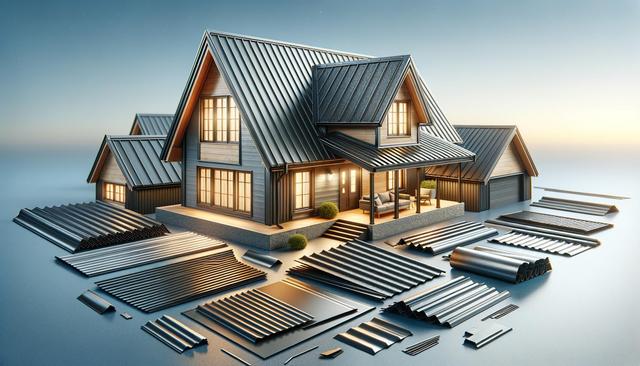
A Comprehensive Guide to Metal Roofing for Homeowners
Understanding the Advantages of Metal Roofing
Metal roofing has gained significant popularity in both residential and commercial construction thanks to its long-lasting performance and practical benefits. Unlike traditional roofing materials, metal roofs offer exceptional resistance to weather elements such as wind, rain, snow, and even fire. Homeowners are increasingly turning to metal roofing because it can last 40 to 70 years, far surpassing the lifespan of many other roofing materials.
Some of the key advantages of metal roofing include:
- Durability: Resistant to cracking, shrinking, and erosion.
- Energy Efficiency: Reflects solar radiant heat, reducing cooling costs.
- Environmental Friendliness: Often made from recycled materials and fully recyclable at the end of their life.
- Low Maintenance: Requires less frequent repairs and upkeep compared to other roofing types.
These characteristics make metal roofs a strong investment for homeowners looking to increase their property’s value while reducing long-term maintenance and energy expenses.
Types of Metal Roofing Materials
Metal roofing comes in a variety of materials, each offering unique features and aesthetics. The most common types include steel, aluminum, copper, and zinc. Steel is widely used due to its strength and affordability, often coated with a protective layer to prevent corrosion. Aluminum is lightweight and highly resistant to rust, making it ideal for coastal areas. Copper and zinc, though more expensive, are praised for their longevity and distinctive appearance as they develop a patina over time.
Styles of metal roofing also vary, including:
- Standing Seam: Vertical panels with interlocking seams, known for a sleek and modern look.
- Metal Shingles: Mimics the appearance of traditional materials like slate, tile, or wood.
- Corrugated Panels: Wavy or ribbed panels often used in agricultural or industrial applications, now gaining popularity in residential projects.
Choosing the right material and style depends on factors such as climate, budget, architectural style, and personal preferences. Consulting with a roofing professional can help determine the most suitable option for your home.
The Metal Roof Installation Process
Installing a metal roof involves several critical steps to ensure a secure and weather-tight finish. While some homeowners may consider DIY installation, it’s typically recommended to hire experienced contractors, especially for complex roof designs or steep slopes. Proper installation is key to maximizing the roof’s lifespan and performance.
The general installation process includes:
- Preparation: Removing old roofing materials (if necessary) and inspecting the decking for damage.
- Underlayment Installation: Applying a weather-resistant barrier to protect against moisture infiltration.
- Panel Placement: Laying and securing the metal panels or shingles with fasteners and clips, ensuring proper alignment.
- Sealing and Flashing: Installing flashing around roof edges, valleys, vents, and chimneys to prevent leaks.
- Final Inspection: Verifying that all components are correctly installed and weatherproofed.
Depending on the size and complexity of the roof, the process can take several days to a week. It’s important to plan for weather conditions and discuss timelines and warranties with your contractor in advance.
Maintenance Tips for Long-Lasting Performance
One of the appealing features of metal roofing is its low maintenance requirements. However, regular inspections and minor upkeep can extend its life and maintain its appearance. Seasonal checks—especially after severe weather—help identify potential issues before they escalate.
Here are some practical maintenance tips:
- Remove leaves and debris from the roof and gutters to prevent water buildup.
- Inspect for signs of corrosion, especially around fasteners and seams.
- Check flashing and sealant for cracks or wear, and reseal if necessary.
- Ensure tree branches don’t rub against the roof, which can damage the finish.
- Schedule professional inspections every few years to assess overall condition.
Most metal roofing systems come with warranties ranging from 20 to 50 years. Following manufacturer guidelines for maintenance and care can help you make the most of your investment.
Cost Considerations and Long-Term Value
While metal roofing typically involves a higher upfront cost compared to asphalt shingles or other options, the long-term benefits often outweigh the initial expense. The durability, energy savings, and minimal maintenance contribute to a lower total cost of ownership over time.
Factors that affect the cost of metal roofing include:
- Material type: Copper and zinc are more expensive than steel or aluminum.
- Roof complexity: Steeper slopes, multiple angles, and architectural details can increase labor costs.
- Installation fees: Vary depending on region and contractor experience.
- Additional features: Insulation, coatings, and custom finishes may add to the cost.
Despite the higher initial investment, homeowners often find that metal roofs enhance property value and offer peace of mind through long-lasting protection. Additionally, the energy efficiency can lead to substantial savings on heating and cooling bills, making it a financially sensible option in the long run.
Conclusion: Is Metal Roofing Right for You?
Metal roofing presents a compelling option for homeowners seeking longevity, energy efficiency, and low maintenance. With a variety of materials and styles available, it can suit different architectural preferences and regional climates. While the upfront cost may be higher, the long-term value is often reflected in reduced energy bills, fewer repairs, and extended durability. By understanding the benefits, installation process, and care requirements, you can make an informed decision about whether a metal roof aligns with your home improvement goals. Whether you’re building a new home or considering a roof replacement, metal roofing is certainly worth exploring as a reliable and efficient solution.


